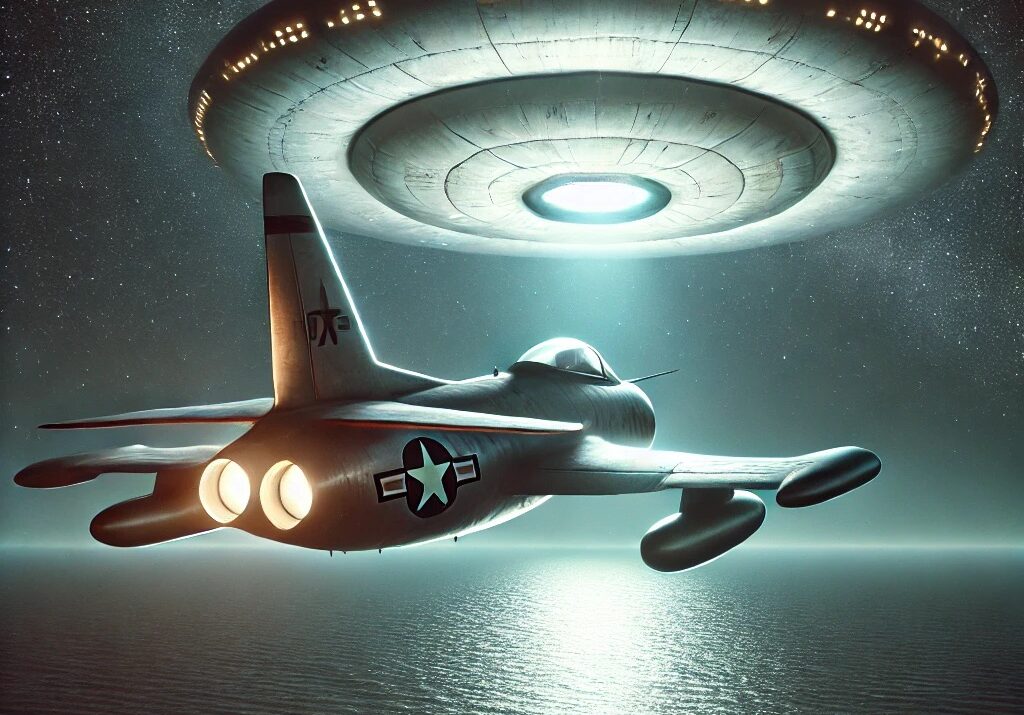The Kinross UFO Incident is one of the most perplexing and enduring mysteries in the annals of UFO history. It involves the disappearance of a United States Air Force F-89C Scorpion interceptor and its two-man crew over Lake Superior on November 23, 1953. The case has been shrouded in controversy, speculation, and various theories for decades, as no trace of the aircraft or its crew has ever been found. Unlike other UFO sightings where witnesses can recount strange lights or unidentified objects in the sky, the Kinross Incident stands out because it resulted in the complete disappearance of a military aircraft and its crew, sparking intense debate and investigation.
The incident occurred during the height of the Cold War, a time when any unidentified object in the skies could have serious implications for national security. The United States Air Force was on high alert, ready to respond to any potential threat, whether from the Soviet Union or otherwise. This context is crucial in understanding the seriousness with which the military took the situation, making the disappearance of the F-89C Scorpion all the more alarming.
INCIDENT SUMMARY
On the evening of November 23, 1953, an F-89C Scorpion interceptor was scrambled from Kinross Air Force Base in Michigan to intercept an unidentified flying object (UFO) that had been detected over Lake Superior. The unknown object had violated restricted airspace, a serious matter during the Cold War when tensions between the United States and the Soviet Union were at their peak. The radar operators at the base tracked the object moving at a considerable speed and altitude, which could not be immediately identified as a commercial or military aircraft.
The aircraft, piloted by Lieutenant Felix Moncla and radar operator Second Lieutenant Robert Wilson, was quickly dispatched to investigate the object. As the F-89C approached the unknown object, ground radar operators observed a peculiar event: the radar returns from the F-89C and the UFO merged into a single blip before both disappeared from the radar screen. Despite extensive searches conducted by air and sea, no trace of the aircraft or its crew was ever recovered. The sudden disappearance of the aircraft has led to a myriad of theories, ranging from the plausible to the outlandish. Some suggest a catastrophic mid-air collision, while others speculate about abduction by an extraterrestrial craft. The absence of wreckage and the mysterious circumstances have kept this incident alive in the public imagination for decades.
DETAILS
- LOCATION: Kinross Air Force Base, Michigan, over Lake Superior.
- DATE: November 23, 1953.
- TIME: Approximately 6:22 PM EST.
- EVENT DURATION: Around 30 minutes
- NUMBER OF OBJECTS: One
- OBJECT(S) SHAPE: No specific shape was visually confirmed.
- DESCRIPTION OF THE OBJECT(S): No specific shape was visually confirmed.
- ALIEN(S) ENCOUNTERED: None.
- DESCRIPTION OF ALIEN(S): Not applicable.
- CE CLASSIFICATION: CE2 (Close Encounter of the Second Kind)
• Sightings of a UFO within 500 feet where physical effects are observed.
• In this case, the disappearance of the F-89C Scorpion and its crew after merging with the unknown object could suggest a significant physical effect.
WITNESSES
The witnesses to the Kinross UFO Incident include military personnel who were directly involved in tracking and responding to the unidentified object, as well as those involved in the search and rescue operations that followed. These individuals provide crucial accounts that help piece together the events of that night, though the mystery remains unresolved.
- LIEUTENANT FELIX MONCLA: The pilot of the F-89C Scorpion, Lieutenant Felix Moncla, was an experienced aviator with a solid military background. Moncla had logged many hours of flight time, and his mission that night was a routine intercept of an unidentified aircraft. However, what was meant to be a standard operation turned into a tragic mystery. Moncla was known for his calm demeanor and precise flying skills, making his disappearance even more puzzling. His sudden and unexplained vanishing during a routine mission continues to raise questions about what really happened that night. Moncla was a dedicated serviceman, and his loss was a devastating blow to his family and colleagues, who were left with no answers and no closure.
- SECOND LIEUTENANT ROBERT WILSON: The radar operator on board the F-89C Scorpion, Second Lieutenant Robert Wilson, was responsible for assisting Moncla in tracking the unidentified object. Wilson’s role was crucial in ensuring the successful interception of unknown aircraft. Despite the tension of the Cold War era, where intercept missions were common, nothing could have prepared Wilson for the events that unfolded that night. His experience and dedication to his duties add a layer of mystery to his disappearance alongside Moncla. Wilson’s family, like Moncla’s, was left without answers, deepening the tragedy of the incident. The loss of Wilson, a promising officer with a bright future, is a stark reminder of the dangers faced by those serving in the armed forces, especially during a time of global tension.
- GROUND RADAR OPERATORS AT KINROSS AIR FORCE BASE: The radar operators at Kinross Air Force Base were the first to detect the unidentified object and track its movements. These operators were trained to identify and monitor all aerial activity within their radar’s range, and they immediately recognized that the object over Lake Superior was not a standard aircraft. Their accounts are critical, as they provide the only official record of the object and the disappearance of the F-89C Scorpion. They described seeing the two radar blips—one representing the F-89C and the other the unidentified object—merge into one before vanishing entirely. This unexplainable radar event has become one of the key mysteries of the Kinross Incident. The radar operators’ testimony has been scrutinized over the years, but no definitive explanation has been provided for the strange radar readings, leaving their accounts as some of the most compelling evidence in the case.
- CANADIAN RADAR OPERATORS: Operators at a radar station in Sault Ste. Marie, Ontario, were also monitoring the unidentified object and the interceptor. Their radar systems picked up the same mysterious blip that was tracked by the Kinross base. The Canadian operators confirmed the disappearance of the F-89C Scorpion after it merged with the unidentified object, providing corroborative evidence that this was not just a glitch in the radar system. The involvement of Canadian radar operators adds an international dimension to the incident, further complicating the investigation and raising questions about the nature of the object that led to the disappearance of the American aircraft. Their accounts have been crucial in confirming that the incident was not an isolated radar anomaly, but a real and unexplained event that crossed international boundaries.
CONCLUSION
The Kinross UFO Incident remains an unsolved mystery, with the disappearance of Lieutenant Felix Moncla and Second Lieutenant Robert Wilson still unexplained after more than seven decades. Despite numerous theories—ranging from a mid-air collision with a UFO to an accidental crash into Lake Superior—no definitive evidence has surfaced to explain what happened that night. The incident has been the subject of multiple investigations, including those by the United States Air Force, which initially classified the disappearance as a mid-air collision. However, the lack of physical evidence and the strange radar data have kept the door open for alternative explanations, including more speculative theories involving extraterrestrial intervention.
In the years following the incident, various researchers and UFO enthusiasts have attempted to piece together what might have happened. Some suggest that the unidentified object was a secretive Soviet aircraft or a misidentified weather balloon, though these explanations fail to account for the radar data or the complete absence of wreckage. Others believe that the object was an extraterrestrial craft, pointing to the radar merge and disappearance as evidence of a close encounter of the second kind or even the third kind. However, without concrete evidence, these theories remain speculative.
The Kinross Incident has also become a focal point for discussions about the possibility of government cover-ups and the extent to which military and intelligence agencies might go to conceal the truth about UFO encounters. Some suggest that the U.S. government may know more about the incident than it has publicly disclosed, citing the lack of transparency and the rapid closure of the investigation as suspicious. The incident has been referenced in numerous books, documentaries, and articles as a prime example of an unexplained military encounter with a UFO, fueling ongoing interest and debate within the UFO community.
What is certain is that the Kinross Incident continues to capture the imagination of those interested in UFO phenomena and unexplained disappearances. This enduring mystery has led to numerous documentaries, books, and articles exploring every conceivable angle. Yet, the truth remains elusive, locked away in the depths of Lake Superior or perhaps beyond our current understanding of the world. As new technology and investigative methods develop, there is always hope that the Kinross UFO Incident may one day be resolved, providing closure to the families of Moncla and Wilson and answers to the countless people intrigued by this cold case in the annals of UFO history.








